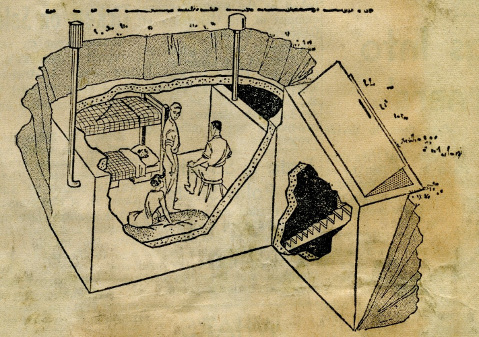
The 1950s and 1960s of the Cold War was a period of great international tension; the threat of nuclear annihilation at the hands of the Soviet Union hung in the air. Santa Barbara was no different in this regard than anywhere else in the country, and the response on the part of some was to build bomb shelters, also known as fallout shelters.
In the early 1960s, many had little doubt that should it come down to a nuclear confrontation, the Santa Barbara area would be a primary target due to its proximity to Vandenberg Air Force Base. What exactly would be the result of an attack on the base was a matter of conjecture. Some experts felt Santa Barbarans would have around two hours warning. Others estimated the town would have no more than 30 to 45 minutes before the radioactive fallout would begin to settle here.
Plans had been put in place to designate certain buildings as public shelters, including the Museum of Art, the Granada Building, and the Historical Museum. At the most, though, these sites would only be able to accommodate some 2,000 people in a town that then had a population of a little over 60,000. To some, therefore, it was apparent they would have to fend for themselves.
The federal Office of Civil Defense listed five basic designs for private shelters, three of which were underground. The Federal Housing Authority offered financing at favorable terms for shelter construction. Concrete was the favored building material, with walls at least 12 inches thick. Shelters were not roomy affairs; one local built a 9-by-14-foot shelter meant to hold two adults and four children. Shelters were stocked with canned goods, lanterns, sleeping bags, and drinking water. One very important item was a battery-powered radio so one could tune into CONELRAD (CONtrol of ELectromagnetic RADiation, 640 or 1240 on the AM radio dial) for information and instructions. Families needed to plan for a stay of two weeks in their shelters.
One contractor estimated it cost around $2,000 to build a shelter in Santa Barbara. One Montecito resident spent $5,000 to construct a shelter with 3-foot-thick walls adorned with a shake roof and decorative ironwork. Locals were of varying minds concerning the efficacy of shelter construction. One Hope Ranch resident, having built a shelter, shortly thereafter came to the conclusion it had been a waste of money and manpower. Yet another citizen built his shelter from a traditional Santa Barbara material, adobe brick, and expressed concern over how to keep others out should the unthinkable occur.
Interest in shelter construction waned as the ’60s progressed. Although inquiries about building permits numbered in the hundreds, very few shelters were actually built. Changes in the Cold War atmosphere and growing doubts about the effectiveness of bomb shelters slowed the rush to build. The Office of Civil Defense morphed into the Federal Emergency Management Agency (FEMA), which today emphasizes measures against natural disasters. Those local shelters that were built now serve as storage units or wine cellars.
Michael Redmon, director of research at the Santa Barbara Historical Society, will answer your questions about Santa Barbara’s history. Write him c/o The Independent, 122 W. Figueroa St., Santa Barbara, CA 93101.



